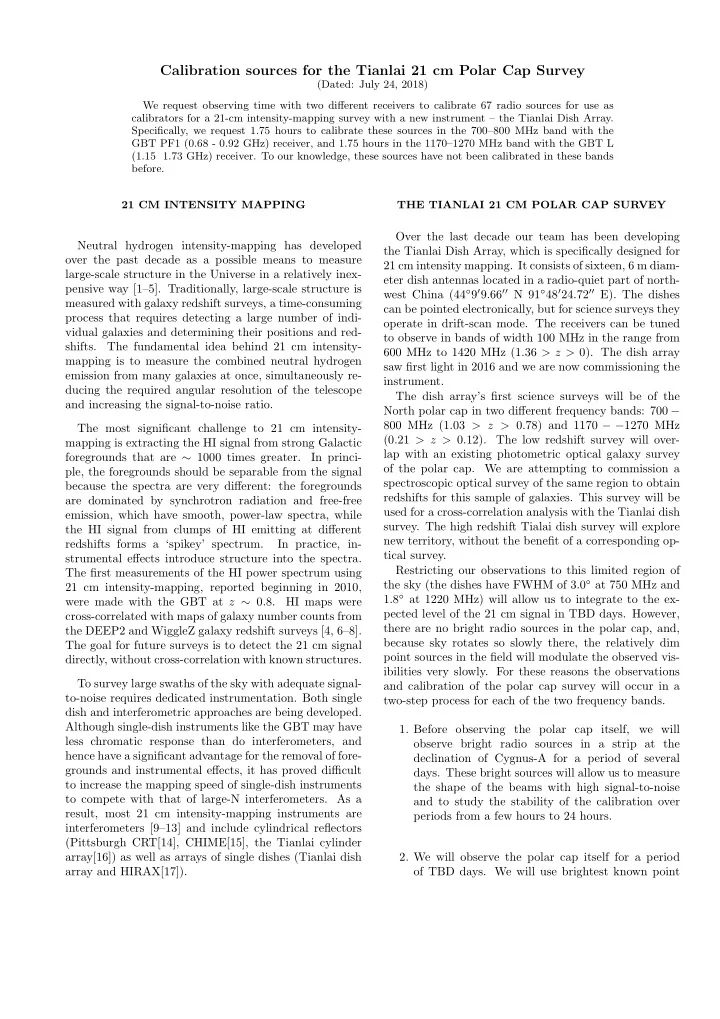

Calibration sources for the Tianlai 21 cm Polar Cap Survey (Dated: July 24, 2018) We request observing time with two different receivers to calibrate 67 radio sources for use as calibrators for a 21-cm intensity-mapping survey with a new instrument – the Tianlai Dish Array. Specifically, we request 1.75 hours to calibrate these sources in the 700–800 MHz band with the GBT PF1 (0.68 - 0.92 GHz) receiver, and 1.75 hours in the 1170–1270 MHz band with the GBT L (1.15 1.73 GHz) receiver. To our knowledge, these sources have not been calibrated in these bands before. 21 CM INTENSITY MAPPING THE TIANLAI 21 CM POLAR CAP SURVEY Over the last decade our team has been developing Neutral hydrogen intensity-mapping has developed the Tianlai Dish Array, which is specifically designed for over the past decade as a possible means to measure 21 cm intensity mapping. It consists of sixteen, 6 m diam- large-scale structure in the Universe in a relatively inex- eter dish antennas located in a radio-quiet part of north- pensive way [1–5]. Traditionally, large-scale structure is west China (44 ◦ 9 ′ 9 . 66 ′′ N 91 ◦ 48 ′ 24 . 72 ′′ E). The dishes measured with galaxy redshift surveys, a time-consuming can be pointed electronically, but for science surveys they process that requires detecting a large number of indi- operate in drift-scan mode. The receivers can be tuned vidual galaxies and determining their positions and red- to observe in bands of width 100 MHz in the range from shifts. The fundamental idea behind 21 cm intensity- 600 MHz to 1420 MHz (1 . 36 > z > 0). The dish array mapping is to measure the combined neutral hydrogen saw first light in 2016 and we are now commissioning the emission from many galaxies at once, simultaneously re- instrument. ducing the required angular resolution of the telescope The dish array’s first science surveys will be of the and increasing the signal-to-noise ratio. North polar cap in two different frequency bands: 700 − 800 MHz (1 . 03 > z > 0 . 78) and 1170 − − 1270 MHz The most significant challenge to 21 cm intensity- (0 . 21 > z > 0 . 12). The low redshift survey will over- mapping is extracting the HI signal from strong Galactic lap with an existing photometric optical galaxy survey foregrounds that are ∼ 1000 times greater. In princi- of the polar cap. We are attempting to commission a ple, the foregrounds should be separable from the signal spectroscopic optical survey of the same region to obtain because the spectra are very different: the foregrounds redshifts for this sample of galaxies. This survey will be are dominated by synchrotron radiation and free-free used for a cross-correlation analysis with the Tianlai dish emission, which have smooth, power-law spectra, while survey. The high redshift Tialai dish survey will explore the HI signal from clumps of HI emitting at different new territory, without the benefit of a corresponding op- redshifts forms a ‘spikey’ spectrum. In practice, in- tical survey. strumental effects introduce structure into the spectra. Restricting our observations to this limited region of The first measurements of the HI power spectrum using the sky (the dishes have FWHM of 3 . 0 ◦ at 750 MHz and 21 cm intensity-mapping, reported beginning in 2010, 1 . 8 ◦ at 1220 MHz) will allow us to integrate to the ex- were made with the GBT at z ∼ 0 . 8. HI maps were pected level of the 21 cm signal in TBD days. However, cross-correlated with maps of galaxy number counts from there are no bright radio sources in the polar cap, and, the DEEP2 and WiggleZ galaxy redshift surveys [4, 6–8]. because sky rotates so slowly there, the relatively dim The goal for future surveys is to detect the 21 cm signal point sources in the field will modulate the observed vis- directly, without cross-correlation with known structures. ibilities very slowly. For these reasons the observations To survey large swaths of the sky with adequate signal- and calibration of the polar cap survey will occur in a to-noise requires dedicated instrumentation. Both single two-step process for each of the two frequency bands. dish and interferometric approaches are being developed. Although single-dish instruments like the GBT may have 1. Before observing the polar cap itself, we will less chromatic response than do interferometers, and observe bright radio sources in a strip at the hence have a significant advantage for the removal of fore- declination of Cygnus-A for a period of several grounds and instrumental effects, it has proved difficult days. These bright sources will allow us to measure to increase the mapping speed of single-dish instruments the shape of the beams with high signal-to-noise to compete with that of large-N interferometers. As a and to study the stability of the calibration over result, most 21 cm intensity-mapping instruments are periods from a few hours to 24 hours. interferometers [9–13] and include cylindrical reflectors (Pittsburgh CRT[14], CHIME[15], the Tianlai cylinder array[16]) as well as arrays of single dishes (Tianlai dish 2. We will observe the polar cap itself for a period array and HIRAX[17]). of TBD days. We will use brightest known point
Recommend
More recommend